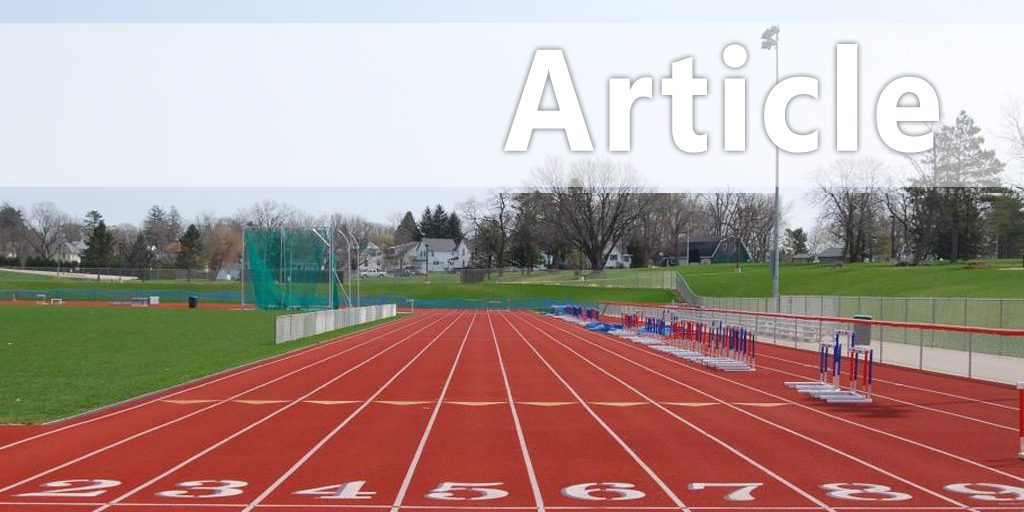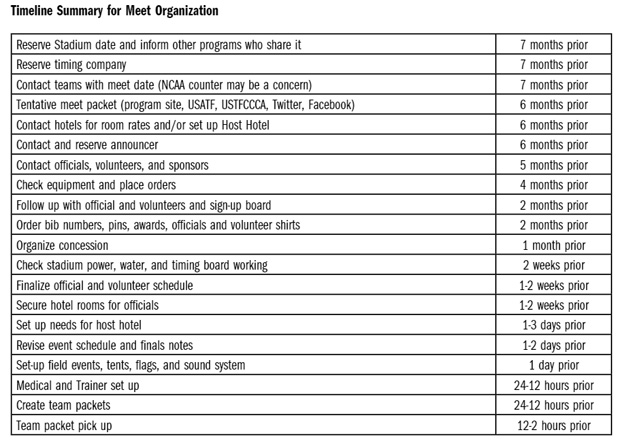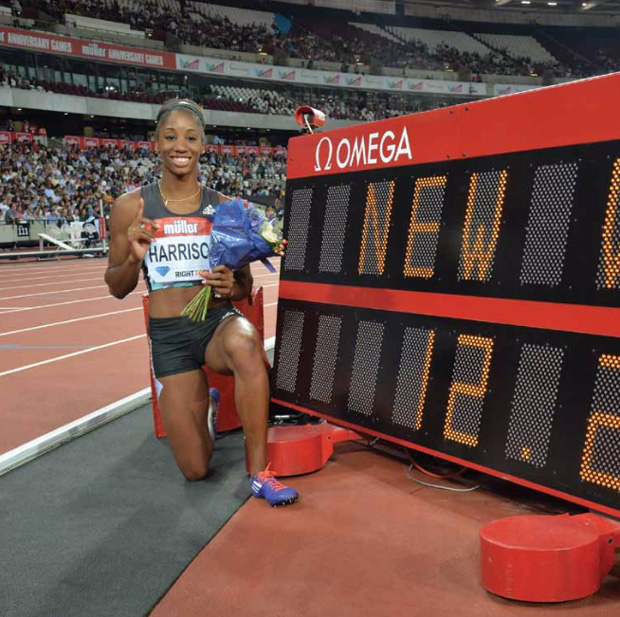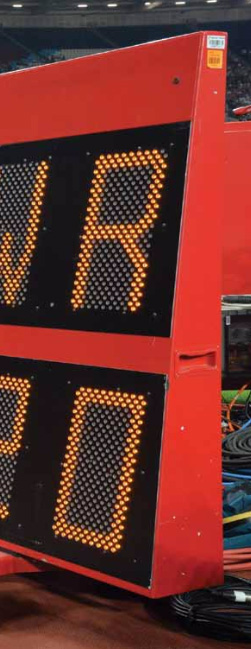| Meet Director: Planning and Management |
| By: Austin Brobst, M.S. and Leo Settle, M.S.
Originally Published in: Techniques Magazine Provided by: USTFCCCA Whether this is the first meet you put on or if you are a seasoned veteran, meet management and planning will always have an element of surprise and excitement. The aim of this article is to provide valuable meet management suggestions and assist with the planning and management time line. Keep in mind each meet and facility are unique, thus making creativity and flexibility important when matching event needs to environment. Organizing and hosting a track meet is a large yet rewarding under-taking by a program. The easiest way to approach a home meet is breaking the event into smaller tasks. Smaller tasks become less intimidating, feasible, and easier to handle when tackled one or two at a time over an extended period of time. Below we have outlined the tasks and corresponding timeline, followed by expansion on the most important areas: SIX MONTHS PRIOR TO THE MEET General Meet Preparations Summer and Fall tend to be more relaxed times for coaches and support staff, during these periods it is recommended that the initial tasks associated with hosting a home meet or meets be put into place. These initial items include reserving appropriate facilities, reserving the timing company, provide participating institutions meet information and receive their confirmation of attendance. In order to help with this process, one can send out emails directly to coaches or utilized social media (Facebook, Twitter, etc.). When sending out initial meet dates and times, it is also recommended to send a tentative copy of the meet schedule to the programs in order to allow travel and budget planning.
Hotel Rooms Due to an increase in occupancy at hotels during most meets it is a good idea to secure room rates and/or blocks for teams to utilize during their stay. The easiest way to secure rates and/or blocks through the sales manager at the hotel(s). From our experience we have found that most hotels are accommodating to work with because they want their rooms occupied and revenue being brought to the property. Once an agreed upon rate has been worked out with the respective hotel(s) it is recommended that this information and a contact at the hotel in the meet information. When working with hotels it is important to remember that individuals associated with the meet production might need lodging as well, such as timing company and officials, so make sure to reserve a block of rooms for those individuals. If the rooms are not utilized they can always be released back to the teams. Announcer The meet announcer is a key piece in the production of the meet. This individual should have a vast knowledge of track and field, the meet schedule, rules, and current records. When seeking an announcer, it's important to find an individual who has the ability to speak clearly, fluidly, expressively, and convey the facts, mood, and feeling of current events. Announcers not only serve in the roll of informing spectators and competitors of what is happening within the meet, but can also provide updates from events not on the oval. Logistically the announcer should have communication with field event officials, the host institution coaching staff, and the timing company. Communication can occur thought multiple platforms such as walkie talkie, cell phone, and/or group messaging apps. Timing Company A professional timing company will need to be confirmed at least six months in advance. Good timing companies bid for quality meets and will fill their annual schedule quickly. Your contract with the timing company should spell out specifically what services they will provide and include a detailed list of equipment that they will provide.
FIVE TO TWO MONTHS PRIOR TO THE MEET Officials Having a competent officiating crew is as important as having a timing company. Officiating meets can be long hours and sometimes in less than ideal conditions, because of this, as a meet director one should plan to dedicate an adequate amount of the overall meet budget to compensating officials accordingly. The following are recommendations for areas that traditionally need certified officials and a minimum number: 1. Starters (2) 2. Clerk of Course (1) *This individual needs to have a great track and field knowledge as they will be the "director" of all things track related 3. Finish Line/Lap Counter (2) 4. Check-In (1) 5. Exchange Zones (3) 6. Vertical Jumps (2 at each event) 7. Horizontal Jumps (3 at each pit depending on measuring device) 8. Throws (2 at each event) *Note that these are just the minimum number of certified officials that should be available for each event, there is still a significant need for "helpers" which will be addressed later in this article. Finding individuals who are willing to forfeit their Friday/Saturday/ Sunday to work a track meet is often times the most difficult task, which makes it important to compensate these individuals for their time. Traditionally, head officials at an event would receive about $100.00-$150.00 a day and their assistants would receive $50.00-$75.00 per day depending on the final numbers of the event. When starting to create a pool of officials a good starting point is the local USATF Association as they traditionally have an email list or list serve of qualified officials in the area. Initially when contacting officials, it's recommended to ask their preferred event and secondary event. Having this information will allow the coordinator of officials to assign individuals to appropriate areas. It is important to remember the officials are choosing to work your meet instead of pursuing other activities so, therefore try to place the officials in events where they feel most qualified. Volunteers Track and field events require a generous number of volunteers. Key volunteer duties include hurdle crew, sand pit raking, implement retrievers, clerk of the course, and finish line, these are the "helpers" mentioned earlier. There are many community organizations that require a certain number of volunteer hours such as: campus Greek life, businesses, scout troops, troubled youth programs, youth organizations, and military. In addition to the above organizations noncompeting student-athletes can serve in a non-officiating capacity. Volunteers should be approached similar to officials in that they could have other more pressing activities to be doing on a Friday/Saturday/Sunday, making it important to show appreciation to these groups for their time and effort. To show such appreciation the program can present these individuals and/or groups with a T-shirt, gift, and/ or announcement of the group during the meet. In addition to recognition make sure to provide plenty of food and water for both volunteers and officials. Remember volunteers should be utilized in non-officiating roles, whenever possible, certified officials should be given the power to comment on event discrepancies. Below is a recommendation for the number of volunteers to be placed at each event: 1. Hurdles (10) 2. Start/Finish Line (Minimum of 1) 3. Horizontal Jumps (Minimum of 2 per pit) 4. Vertical Jumps (Minimum of 2 per pit) 5. Throws (Minimum of 2 per event) Equipment Approximately four months prior to the meet one should create a list of equipment requirements and begin to price out and order the necessities. When ordering equipment make sure to place the order in advance to avoid any back order situations and allow enough time for shells, which have to be transported via ground. Below are some key pieces of equipment that are necessary for any home meet: • Shells/blanks for the starter • Crossbars • Measuring tapes (or scopes/lasers) • Chalk for pole vault and throws • Speakers/sound system • Display boards & wind gauges for throw and jump performances • Boards for horizontal jumps • Hip numbers • Tables & chairs for officials • Scales/measuring devices for throwing implements • Starting Blocks Hurdles • Bib numbers & pins • Tents • Flagging ONE MONTH TO ONE WEEK PRIOR TO THE MEET Officials It is recommended to reconnect with officials confirm and they are still available to work. This correspondence also serves as a good time to gather personal information for payment. Once the final headcount of officials is gathered, it's best to send their final duties and assignments on the five or six days prior to the meet, just in case any scheduling conflicts have come up. In addition, when sending out official information, make sure to include report times and officiating groups. When planning for official report times, be sure to factor in warm ups, which are typically one hour prior to events. At this time it is also recommended to find out how many officials will need hotels. It is safe to assume that all out of state officials will need a room, and some in-state officials could fall into this category as well especially if they live a few hours away and the meet runs late into the evening. If possible it's best to have each official in their own room, but if necessary find out from officials if they have a roommate preference. Once it is determined how many hotel rooms you will need, reach back out to the director of sales at the host hotel and have the officials name placed on the reserved room. Also be sure to notify the official which hotel they will be staying at, being sure to include address and point of contact at the hotel should there be any issues. This is also the time to schedule medical authorities (EMS, Fire, etc). Concessions The month prior to the meet is a good time to secure food contracts for student-athletes, officials, and volunteers. When securing contracts or arraignments it helps to be creative with planning, social media, school foundation's, and/or fundraising organizations can help out immensely when it comes to raising capital. This can include supplying a company or restaurant who has donated with publicity via the programs social media outlets, or giving back to the company/organization in terms of volunteer work to help offset some of the associated costs. Facility As the meet approaches, it's important to make sure that the facility is in good shape. The big ticket items that should be checked first are the score board (if you plan to use one for results and meet information), water supply for sand or steeple pits, and power in press boxes, medical area, and other areas where power may be needed. Once all physical preparations are complete, ancillary items like tents, copiers, speaker systems and anything else that might need to be rented should be set up. Security measures should be put in place either through the school or an outside organization to provide security for fans, officials, and student-athletes during the time of meet. WEEK OF THE MEET Schedule Leading up to the week of the meet most of the big-ticket items should be squared away and ready to go, but the details are what can set your meet apart from other meets. First action item on this list should be to finalize the time schedule and make sure that it is feasible to complete all the events in the scheduled time based on final number of entrants. Once registration closes, numbers should be looked at and the schedule should be adjusted accordingly to eliminate down time or extended depending on specific event numbers. A few guidelines to help plan for enough time during and between events is as follows: For field events, a good officiating crew can typically work through each participant in 60-90 seconds per attempt, so it's best to plan for 90 seconds per attempt. Time management is crucial if you only have one pit or throwing area as you'll want to make sure there is ample warm up time between flights and/or genders. For the track events a good starter and clerk can typically get a race staged and ready to go within 90 seconds from the completion of the previous race. That said, take the race time and add about 90 seconds, i.e. for the men's 100 at the college level a good crew should be able to fire the gun every two minutes. When setting up an indoor schedule if your facility doesn't have a separate high jump area your straight sprint and hurdle events should be run first to allow high jump to occur while all oval events are taking place. The same is true during the outdoor season with javelin and the high jump apron. Facility During the week of the meet it is recommended to plan for the facility to be ready to go at least 24 hours prior to it being open for warm ups. This includes the following: • Flagging set up to keep athletes and spectators out of areas that shouldn't be accessed • Tents set up for teams • Appropriate signage in place for visiting teams and spectators • Field event pits/fields/boards are prepped and installed (if needed) • Sound system has been checked and is ready for operation • Timing company has necessary connections and power supplies • Hurdles and barriers are stacked or nearby for easy access during race day placement • Clerking area is set up with chairs, hip numbers, etc Medical When setting up the medical area it is important to remember that there will more than likely be more than one team set up in the space. With that being said, make sure there is plenty of space and power supplies for various medical devices. Medical areas should also be positioned to allow trainers and EMS quick access to the finish line and area of competition in the event of an emergency. Meet Packet Meet packet pick up is the last central intelligence for coaches. At the time the Meet Packet is picked up it should be verified that the program has paid their entry fee, either online or in person. Inside the Meet Packet should be the following information: • Coach and athlete credentials • Bib numbers • Finals Schedule • Heat sheets • Implement weigh-in time and location • Check-in time and location • Clerk of the course reporting time • Coaching boxes • Hospitality tent • Relay cards • Site Map REVENUE Creating revenue from cross country/ track and field meets can be a difficult task, even when dealing with events like the NCAA Championships. We have found the best way to create a revenue stream is through team/individual entry fee, merchandise/concession, and admission costs. Entry fee can vary depending on the quality of the meet as well as quantity of student-athletes. An effective way to determine entry fee is to examine what other institutions are charging and base the rates accordingly. Merchandise and concession sales will be your second highest revenue stream. When working with merchandise and concessions it is best to check with the marketing department at the university because there could be previous contracts established with certain vendors for athletic events. If such contracts do not exist then it is recommended to reach out to local screen printers and catering companies and see what contract terms can be reached for the meet. The third and final potential revenue stream is admission to the meet. Depending on the institution, meet admission costs may be handled by Event Management. If your institution does not have an Event Management staff in place it is recommended to keep ticket costs in line with the admission to other sporting events, somewhere between the $5-$30. A marketing rule of thumb when setting admission fees is you want to keep the total cost equivalent to attending a movie, as this is the average dollar amount a family will spend on a Friday or Saturday. OVERVIEW While a great deal of planning and preparation are required to host a successful home meet, the rewards are equally as great. Student-athletes will feel more comfortable competing at home, which can lead to better performances. The program will be setting a precedent within the community that the institution values community-based events and welcomes everyone in the surrounding area to attend local gatherings. ------------------------------------------------------------------------ Austin Brobst, M.S. is an assistant coach Northwestern University. Leo Settle, M.S. is an assistant coach at the University of Texas at El Paso. Both Brobst and Settle tenured at University of New Mexico and during their time the program hosted several Championships including: Mountain West Conference (Cross Country, Indoors, and Outdoors) and USATF Indoors Championships. A special thank you to Dr. Richard Ceronie. Without his years of meet management experience and guidance, much of this article would not have been possible. |






 It is imperative for the timing company hardware and software equipment to be NCAA and USATF compliant. The hardware should be functional for any type of weather. The software should be compatible with the meet management entry platform. Some track programs may need to manage and submit the electronic entry file to the company, whereas some companies completely handle the entry process as part of their service. The timer should be compliant with submitting the final results to the Track & Field Results Reporting System (TFRRS) and/or USATF systems. Finally, the contract should spell out what the needs of the timing are for hotel rooms and number of nights and/or overnight storage for equipment.
It is imperative for the timing company hardware and software equipment to be NCAA and USATF compliant. The hardware should be functional for any type of weather. The software should be compatible with the meet management entry platform. Some track programs may need to manage and submit the electronic entry file to the company, whereas some companies completely handle the entry process as part of their service. The timer should be compliant with submitting the final results to the Track & Field Results Reporting System (TFRRS) and/or USATF systems. Finally, the contract should spell out what the needs of the timing are for hotel rooms and number of nights and/or overnight storage for equipment.


